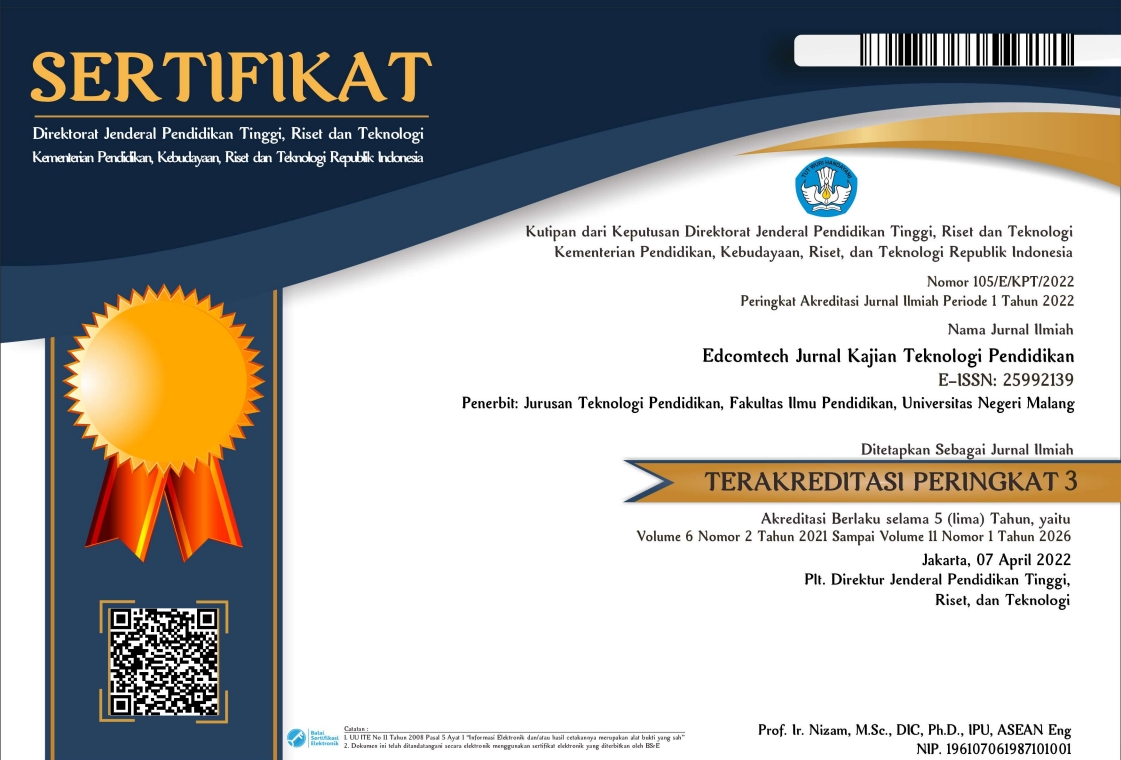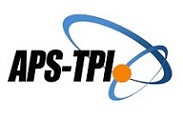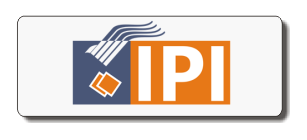Pengaruh Model SAVI Berbantuan Software Pengendali Client terhadap Tingkat Kedisiplinan dan Hasil Belajar Matematika
Abstract
Abstrak: Penelitian ini bertujuan untuk mengetahui pengaruh model pembelajaran SAVI (Somatic, Auditory, Visualization, Intellectually) berbantuan software pengendali client terhadap tingkat kedisiplinan dan hasil belajar Matematika pada siswa kelas V. Desain penelitian ini menggunakan eksperimental semu (quasi experiment) dengan bentuk nonequivalent control group design. Teknik pengumpulan data dengan metode observasi, wawancara dan tes. Hasil penelitian menunjukkan model pembelajaran SAVI berbantuan software pengendali client berpengaruh terhadap tingkat kedisiplinan siswa pada mata pelajaran Matematika. Namun, tidak ditemukan adanya perbedaan signifikan antara hasil belajar matematika antara siswa pada kelompok kontrol dan perlakuan. Kesimpulan dari penelitian ini adalah model pembelajaran SAVI berbantuan software pengendali client mempunyai pengaruh yang signifikan terhadap kedisiplinan siswa. Rekomendasi untuk penelitian selanjutnya adalah model pembelajaran SAVI dapat dikombinasikan dengan media yang lain. Penelitian ini tidak berlangsung secara sempurna dikarenakan pandemi Covid-19.
Abstract: This research aims to determine the effect of SAVI (Somatic, Auditory, Visualization, Intellectually) learning model assisted by client control software on the level of discipline and mathematics learning outcomes in fifth grade. This research design using quasi experimental (quasi experiment) with the form of the nonequivalent control group design. Data collection techniques using observation, interview and test methods. The results showed that the SAVI learning model assisted by client control software had an influence on the level of student discipline in mathematics, but there was no significant difference in student learning outcomes. The conclusion of this study is the SAVI learning model assisted by client controller software has a significant effect on the level of student discipline. The recommendation for further research is that the SAVI learning model can be combined with other media. This research did not take place perfectly due to the Covid-19 pandemic.
Keywords
Full Text:
PDFReferences
Abdulhak, I. (2015). Teknologi Keguruan. PT Remaja Rosdakarya.
Achdiyat, M., & Andriyani, F. (2016). Hasil belajar matematika ditinjau dari model pembelajaran Teams Assisted Individualization (TAI). Formatif: Jurnal Ilmiah Pendidikan MIPA, 6(3), 246–255. https://doi.org/http://dx.doi.org/10.30998/formatif.v6i3.996
Akhtar, S., Warburton, S., & Xu, W. (2017). The use of an online learning and teaching system for monitoring computer aided design student participation and predicting student success. International Journal of Technology and Design Education, 27(2), 251–270. https://doi.org/https://doi.org/10.1007/s10798-015-9346-8
Ariananda, E. S., Hasan, S., & Rakhman, M. (2014). Pengaruh kedisiplinan siswa di sekolah terhadap prestasi belajar siswa teknik pendingin. Journal of Mechanical Engineering Education, 1(2), 233–238. https://doi.org/https://doi.org/10.17509/jmee.v1i2.3805
Carrasco, M. R., & Torrecilla, F. J. M. (2012). Learning environments with technological resources: a look at their contribution to student performance in Latin American elementary schools. Educational Technology Research and Development, 60(6), 1107–1128. https://doi.org/https://doi.org/10.1007/s11423-012-9262-5
Cemara, G. A. G., & Sudana, D. N. (2019). Pengaruh Model Pembelajaran SAVI Bermuatan Peta Pikiran Terhadap Kreativitas dan Penguasaan Kompetensi Pengetahuan IPA Siswa. Jurnal Ilmiah Sekolah Dasar, 3(3), 351–360. https://doi.org/http://dx.doi.org/10.23887/jisd.v3i3.18895
Fabian, K., Topping, K. J., & Barron, I. G. (2018). Using mobile technologies for mathematics: effects on student attitudes and achievement. Educational Technology Research and Development, 66(5), 1119–1139. https://doi.org/https://doi.org/10.1007/s11423-018-9580-3
Gaol, H. A. L. (2014). The Effect of Applying Somatic Auditory Visual Intellectual (Savi) Method on Students’achievement in Writing Report Text. TRANSFORM Journal of English Language Teaching and Learning of FBS UNIMED, 3(4), 1–17.
Harron, N. A., Saod, A. H. M., Ramlan, S. A., Abd Razak, F., Ishak, N. H., Sadimin, S., Rashid, A. N. A., & Ismail, N. (2017). ComTrack: Implementation of innovative computer lab management tool for academic institutions. 2017 IEEE Symposium on Computer Applications & Industrial Electronics (ISCAIE), 132–135. https://doi.org/10.1109/ISCAIE.2017.8074964
Mangesti, T. (2016). Pengembangan Instrumen Penilaian Sikap Disiplin Pada Pembelajaran Bahasa Prancis Tingkat SMA Kelas X SMAN 2 Magelang.
Matuk, C. F., Linn, M. C., & Eylon, B.-S. (2015). Technology to support teachers using evidence from student work to customize technology-enhanced inquiry units. Instructional Science, 43(2), 229–257. https://doi.org/https://doi.org/10.1007/s11251-014-9338-1
Naim, N. (2012). Character Building. AR. Ruzzmedia.
Praherdhiono, H., Setyosari, P., Degeng, I. N. S., Slamet, T. I., Surahman, E., Adi, E. P., Degeng, M. D. K., & Abidin, Z. (2019). Teori dan Implementasi Teknologi Pendidikan: Era Belajar Abad 21 dan Revolusi Industri 4.0. Seribu Bintang.
Puspitasari, A. (2019). Pengaruh Model Pembelajaran SAVI (Somatic, Auditory, Visualization, Intellectual) dengan Media Hide dan Seek Puzzle Terhadap Hasil Belajar IPA. Universitas Muhammadiyah Magelang. http://eprintslib.ummgl.ac.id/id/eprint/61
Rohmadheny, P. S., & Yudiari, N. (2015). Peduli Lingkungan melalui Kontinuitas Pembiasaan Perilaku Buang Sampah pada Tempatnya. PROSIDING SEMINAR NASIONAL “Optimalisasi Active Learning Dan Character Building Dalam Meningkatkan Daya Saing Bangsa Di Era Masyarakat Ekonomi Asean (MEA), 45–49. https://doi.org/http://dx.doi.org/10.23887/jjpgsd.v3i1.5683
Rücker, M. T., & Pinkwart, N. (2016). Review and discussion of children’s conceptions of computers. Journal of Science Education and Technology, 25(2), 274–283. https://doi.org/https://doi.org/10.1007/s10956-015-9592-2
Salvi, A., Konde, R., Karlenaik, P., & Jambhale, S. (2019). An Automated Approach to Supervising and Controlling of Computer Laboratory over LAN. 2019 IEEE 5th International Conference for Convergence in Technology (I2CT), 1–4. https://doi.org/10.1109/I2CT45611.2019.9033596
Sarnoko, S., Ruminiati, R., & Setyosari, P. (2016). Penerapan pendekatan SAVI berbantuan video pembelajaran untuk meningkatkan aktivitas dan hasil belajar IPS siswa kelas IV SDN I Sanan Girimarto Wonogiri. Jurnal Pendidikan: Teori, Penelitian, Dan Pengembangan, 1(7), 1235–1241. https://doi.org/http://dx.doi.org/10.17977/jp.v1i7.6524
Schoenfeld, A. H. (2013). Classroom observations in theory and practice. ZDM, 45(4), 607–621. https://doi.org/https://doi.org/10.1007/s11858-012-0483-1
Shoimin, A. (2013). model pembelajaran inovatif dalam kurikulum 2013. Ar-Ruzz Media.
Sohail, S., Felemban, E., AlThobaiti, B., & AlHetairshi, A. (2011). Smart-Lab, LAN Based Application for Effective Lab Supervision. 2011 Second International Conference on Networking and Distributed Computing, 15–19. https://doi.org/10.1109/ICNDC.2011.11
Sugesti, I. J., Simamora, R., & Yarmayani, A. (2018). Perbandingan Kemampuan Pemecahan Masalah Matematis Menggunakan Model Pembelajaran Savi Dan Model Pembelajaran Langsung Siswa Kelas Viii SMPN 2 Kuala Tungkal. PHI: Jurnal Pendidikan Matematika, 2(1), 14–22. https://doi.org/http://dx.doi.org/10.33087/phi.v2i1.22
Sugiyono. (2015). Metode Penelitian Kuantitatif, Kualitatif dan R&D. Penerbit Alfabeta. file:///C:/Users/HP/AppData/Local/Mendeley Ltd./Mendeley Desktop/Downloaded/Sugiyono - 2015 - Metode Penelitian Kuantitatif, Kualitatif dan R&D.pdf
Sundari, S. (2019). Meningkatkan hasil belajar siswa dalam pembelajaran matematika melalui pendekatan savi pada siswa kelas VB SDIT al-Izzah Sorong. Qalam: Jurnal Ilmu Kependidikan, 5(2), 44–51. https://doi.org/https://doi.org/10.33506/jq.v5i2.260
Yaumi, M. (2018). Media dan teknologi pembelajaran. Prenada Media.
DOI: http://dx.doi.org/10.17977/um039v6i12021p243
Refbacks
- There are currently no refbacks.
Copyright (c) 2021 Stephanus Lukito Cahyo Purnomo, Dedi Kuswandi, Henry Praherdhiono

This work is licensed under a Creative Commons Attribution-ShareAlike 4.0 International License.
Edcomtech: Jurnal Kajian Teknologi Pendidikan published by Department of Educational Technology, Faculty of Education, State University of Malang in Collaboration with Asosiasi Program Studi Teknologi Pendidikan Indonesia (APS TPI) and Ikatan Profesi Teknologi Pendidikan Indonesia (IPTPI) with MoU.
Publisher Address:
Lab. Teknologi Pendidikan, Gd.E2, Lt.1
Fakultas Ilmu Pendidikan Universitas Negeri Malang
Jalan Semarang No 5, Kota Malang Kode Pos 65145
Email: edcomtech.fip@um.ac.id
========================================================================================================
| INDEXED BY | TOOLS | PLAGIARISM CHECK | ARTICLE TEMPLATE |
|

Edcomtech is licensed under a Creative Commons Attribution-ShareAlike 4.0 International License.
Edcomtech Statistics (Since July 13th, 2020)












1.png)








